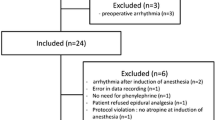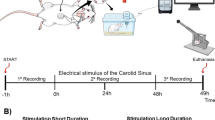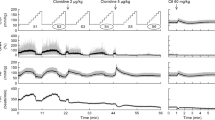Abstract
To investigate the effects of a combination of fentanyl and diazepam on carotid sinus baroreflex in conscious rabbits, we examined the responses of mean systemic arterial pressure (MAP), heart rate (HR) and total peripheral resistance (TPR) to bilateral carotid occlusion (BCO). Seven rabbits were given 0.5 mg·kg−1 of diazepam i.v. followed by 10 mcg·kg−1 of fentanyl i.v. at 5 min intervals (group 1), and the drugs were given in the reverse order to 5 other rabbits (group 2). BCO was repeated in conscious state (control) and after each drug injection. MAP responses did not differ from control response in either group when both drugs were given. In group 1, however, diazepam decreased HR response to 71.4% of control, and increased TPR response by 36%. Fentanyl administration reversed diazepam-induced changes in BCO responses to the control level. In group 2, fentanyl decreased TPR response to 61.6% of control and increased HR response by 41.5%. Administration of diazepam following fentanyl restored HR and TPR responses to control levels. Carotid sinus baroreflex gain was 3.1±0.4 (mean±SEM) in control and 3.1±0.4 after administration of both drugs in 12 rabbits. The results suggest that a sedative dose of either fentanyl or diazepam antagonizes the other drug’s action on the carotid sinus baroreflex. The combination of fentanyl and diazepam has little influence on carotid sinus baroreflex control of the circulation in rabbits.
Similar content being viewed by others
References
Laubie M, Schmitt H: Site of the vagaIly mediated bradycardia induced by morphine-like agents and opioid peptides. Central Nervous System Mechanism in Hypertension. Perspectives in Cardiovascular Research. Edited by Buckly JP, Ferrario CM, New York, Raven, vol 6, 1981,pp. 235–247
Hockman CH, Livingston KE: Inhibition of reflex vagal bradycardia by diazepam. Neuropharmacology 10:307–314, 1971
Ohsumi H, Sakamoto M, Yamazaki T, et al: Effects of fentanyl on carotid sinus baroreflex control of circulation in rabbits. Am J Physiol 256:R625-R631,1989
Sakamoto M, Ohsumi H, Yamazaki T, et al: Effects of diazepam on carotid sinus baroreflex control of circulation in rabbits. Acta Physiol Scand 139:281–287, 1990
Sivam S, Ho IK: Influence of morphine dependence on GABA-stimulated benzodiazepine binding to mouse brain synaptic membranes. Eur J Pharmacol 79:335–336, 1982
Zambotti F, Zonta N, Tammiso R, et al: Reversal of the effect of centrally-administered diazepam on morphine antinociception by specific (Ro 15-1788 and Ro 153505) and non-specific (bicuculline and caffeine) benzodiazepine antagonists. Naunyn-Schmiedeberg’s Arch Pharmacol 333:43–46, 1986
Kotrly KJ, Ebert TJ, Vucins EJ, et al: Effects of fentanyl-diazepamnitrous oxide anaesthesia on arterial baroreflex control of heart rate in man. Br J Anaesth 58:406–414, 1986
Ebert TJ, Kotrly KJ, Madsen KE, et al: Fentanyl-diazepam anesthesia with or without N2O does not attenuate cardiopulmonary baroreflex mediated vasoconstrictor responses to controlled hypovolemia in humans. Anesth Analg 67:548–554, 1988
Daskalopoulos NTH, Laubie M. Schmitt H: Localization of the central sympatho-inhibitory effect of a narcotic analgesic agent, fentanyl in cats. Eur J Pharmacol 33:91–97, 1975
Franz DN, Hare BD, McCloskey KL: Spinal sympathetic nurons: possible sites of opiate-withdrawal suppression by clonidine. Science 215:1643–1645, 1982
Gerold M, Cavero I, Riggenbach H, et al: Analysis of cardiac dhronotropic responses to diazepam in conscious trained dogs. Eur J Pharmacol 35:361–368, 1976
Kissin I, Brown PT, Bradley Jr EL: Morphine and fentanyl anesthetic interactions with diazepam: Relative antagonism in rats. Anesth Analg 71:236–241, 1990
Rosland JH, Hole K: 1, 4-Benzodiazepines antagonize opiate induced antinociception in mice. Anesth Analg 71:242–248, 1990
Dingledine R, Iversen LL, Breuker E: Naloxone as a GABA antagonist: Evidence from ionophoretic receptor binding and convulsant studies. Eur J Pharmacol 47:19–27, 1978
Ticku MK, Huffman R: The effect of acute and chronic morphine administration on GABA receptor binding. Eur J Pharmacol 68:97–106, 1980
Jacquet YF, Saederup E, Squire RF: Non-stereo-specific exitatory actions of morphine may be due to GABAA receptor blockade. Eur J Pharmacol 138:285–288, 1987
Author information
Authors and Affiliations
About this article
Cite this article
Sakamoto, M., Ohsumi, H., Sumida, T. et al. Fentanyl antagonizes diazepam on carotid sinus baroreflex control of circulation in rabbits. J Anesth 7, 210–217 (1993). https://doi.org/10.1007/s0054030070210
Received:
Accepted:
Issue Date:
DOI: https://doi.org/10.1007/s0054030070210




